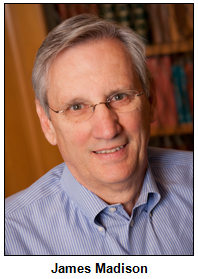Oct 2, 2020
Why did the despicable Ku Klux Klan become pervasive across Indiana during the 1920s?
Who joined? And does the tendency of the general public to focus on Klan Grand Dragon D.C. Stephenson (and his lurid scandals) dilute the more insidious - if less sensationalistic - impact the KKK had on life in Indiana in the 1920s?
 These are
among the questions that acclaimed Indiana
historian James Madison tackles in his
new book, The
Ku Klux Klan in the Heartland (IU Press),
which explores one of the most shameful eras in the Hoosier state.
From 1923 through 1925, the peak of the KKK's influence in Indiana,
"up to one third of the state's native-born, white Protestant men
signed up," Jim Madison notes.
These are
among the questions that acclaimed Indiana
historian James Madison tackles in his
new book, The
Ku Klux Klan in the Heartland (IU Press),
which explores one of the most shameful eras in the Hoosier state.
From 1923 through 1925, the peak of the KKK's influence in Indiana,
"up to one third of the state's native-born, white Protestant men
signed up," Jim Madison notes.
Jim, an IU professor emeritus of history whose honors and awards include being designated a Living Legend by the Indiana Historical Society in 2016, will be Nelson's guest as Hoosier History Live continues its mission to explore all aspects of the state's heritage. Jim Madison's other books include Hoosiers: A New History of Indiana (2014) and A Lynching in the Heartland (2001), which explored the 1930 lynching in Marion, Ind., of two African-American teenagers. That notorious episode was not connected to the KKK.
The Klan that dominated Indiana during the 1920s was the second of three incarnations of the organization in American history, Jim notes. The first, which formed soon after the Civil War, prevailed in Southern states and terrorized African Americans newly freed from slavery.
In contrast, the Klan's primary targets in Indiana during the 1920s were immigrants and Catholics, according to The Ku Klux Klan in the Heartland.

"Klan men and women saw themselves not as bigoted extremists, but as good Christians and good patriots joining proudly in a moral crusade," Jim writes. Membership rosters, he adds, demonstrate that Hoosiers who joined the Klan were not exclusively stereotypical "rubes" lacking in education or sophistication. Instead, membership consisted of "a wide range of people, most from the middle ranks of society. Respectable lawyers, Masons, police officers, churchwomen, teachers, mayors and businessmen joined the Klan in Indiana."
Klan membership cards and receipts for KKK memorabilia in Hamilton County from 1923 to 1926 - discovered during the 1990s in a trunk stored in a barn - are now at the Indiana Historical Society. The documents are available for viewing by the public by making an appointment with the historical society's library.
 Opposition to the Klan did
exist in Indiana. In 1924, hundreds of University of Notre
Dame students protested Klan members, even
pulling off their hoods and throwing potatoes at them, a clash
described in The Ku Klux Klan in the Heartland. Four
years later, the Indianapolis
Times newspaper received
a Pulitzer
Prize for its anti-Klan reporting. Many Hoosiers who
opposed the KKK, though, opted to remain silent.
Opposition to the Klan did
exist in Indiana. In 1924, hundreds of University of Notre
Dame students protested Klan members, even
pulling off their hoods and throwing potatoes at them, a clash
described in The Ku Klux Klan in the Heartland. Four
years later, the Indianapolis
Times newspaper received
a Pulitzer
Prize for its anti-Klan reporting. Many Hoosiers who
opposed the KKK, though, opted to remain silent.
Allies of the Klan included Gov. Ed Jackson, whom Jim Madison describes as "the undisputed holder of the title of the worst governor in Indiana history." At Jackson's inaugural reception in January 1925, Grand Dragon Stephenson stood by his side. Later indicted on charges of attempted bribery, Jackson "escaped jail only on a technicality," Jim writes.
The peak years of Klan membership in Indiana were 1923 and '24. Local chapters, called Klaverns, existed in every county.
World War I, which ended in 1918, "had advanced suspicions of the foreign born . . . anyone not judged to be 100 percent American," according to The Ku Klux Klan in the Heartland. The suspicions swept across Indiana, Jim Madison writes, in part because the state was more homogeneous than many others. Some of the counties with the highest per capita Klan membership had the least diversity.
In 2010, Hoosier History Live explored the Klan's stranglehold on Indiana's political and cultural life during the 1920s. Research by our guest on that show, IU professor emeritus Allen Safianow, assisted Jim Madison in putting together The Ku Klux Klan in the Heartland.